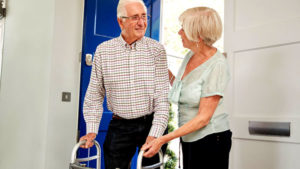As Americans age, seniors are especially at risk of being injured by a fall. But it doesn’t have to be that way. Falls should not be considered a normal, expected result of aging. Nevertheless, they can be serious and costly for older adults.
FACTS ABOUT FALLS
According to the Centers for Disease Control and Prevention:
•One out of five falls causes a serious injury, such as broken bones or a head injury.
•Each year, 2.8 million older people are treated in emergency departments for fall injuries.
•More than 800,000 patients a year are hospitalized because of a fall injury, most because of a head injury or hip fracture.
•Each year at least 300,000 older people are hospitalized for hip fractures.
•More than 95 percent of hip fractures are caused by falling, usually by falling sideways.
•Falls are the most common cause of traumatic brain injuries.
•In 2015, the total medical costs for falls totaled more than $50 billion. Medicare and Medicaid shouldered 75 percent of these costs.
The good news is that while the statistics are certainly alarming, there are things we can do to reduce the chance of falling.
WHAT TO DO
•Tell your healthcare provider right away if you fall, worry about falling or often feel unsteady. Your provider can review your medicines to see if the dosage or combination could be a contributing factor.
•Consult your physician about exercises to improve balance and strength, which could make your legs stronger and lower the chance of falling.
•Have your eyes and ears checked; get updated glasses prescriptions, if needed. You also want to make sure you don’t have glaucoma, cataracts or another condition that limits vision. Poor vision and certain ear disorders that affect balance can increase the chances of falling.
•Footwear that’s too large or loose can also increase falls. Consult a physician or foot health professional to make sure shoes are properly fitted.
HOME ADVICE
Some simple steps to look at around the home include:
•Remove piles or objects you could trip over from stairs and high-traffic areas where you walk. Think magazine racks, electrical cords and newspapers, for example.
•Make sure all stairs are in good condition; repair loose boards or replace missing pieces
•Repair loose wooden floor boards.
•Clean up spills immediately.
•Use double-sided tape to secure throw rugs and prevent them from slipping.
•Install grab bars in the bathroom near the tub and toilet.
•Use non-slip mats in the bathtub or shower.
•Add proper lighting on stairs and access points inside and outside the home.
•Place nightlights in the bathroom, bedroom and hallways, and turn on lights before going up or down stairs.
By following these precautions, we can substantially reduce the likelihood of fall injuries from occurring and help seniors live healthier and safer lives.
MORE INFORMATION
“Safety for Older Consumers – Home Safety Checklist” – United States Consumer Product Safety Commission (2018)
“Important Facts About Falls” – Centers for Disease Control and Prevention (February 2017)
This loss control information is advisory only. The author assumes no responsibility for management or control of loss control activities. Not all exposures are identified in this article. Visit Landmark Risk Management & Insurance for insurance coverage information and advice.

